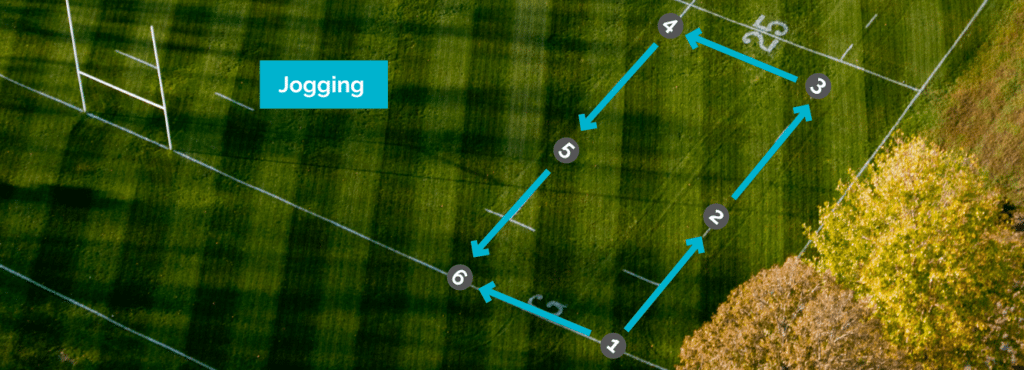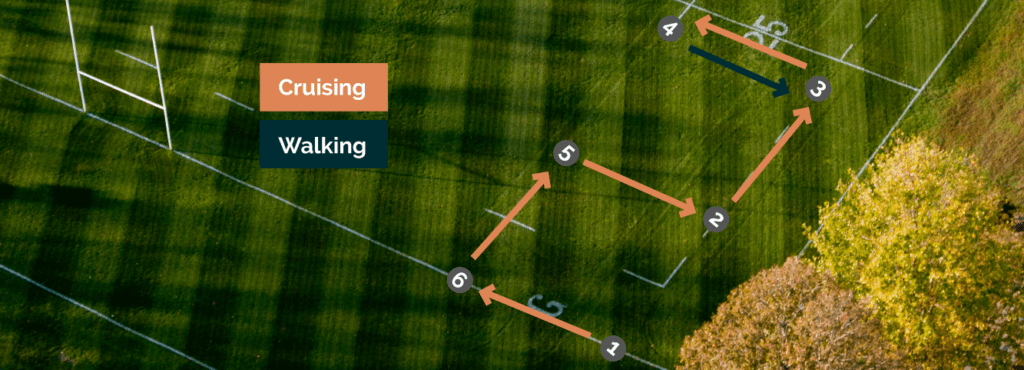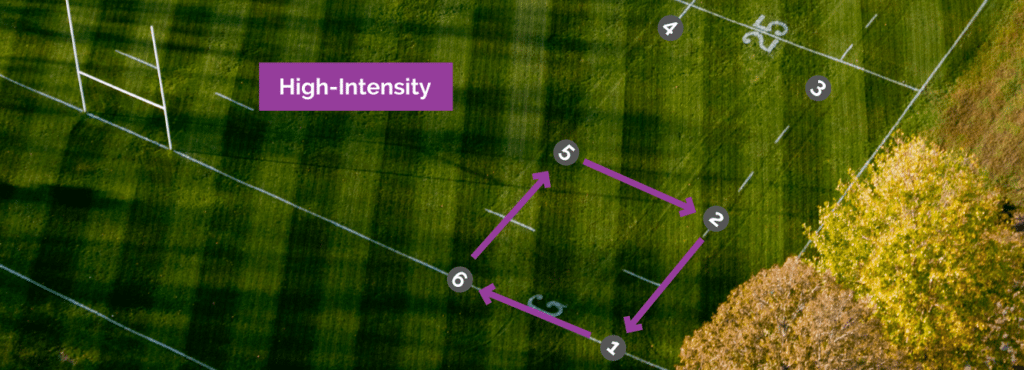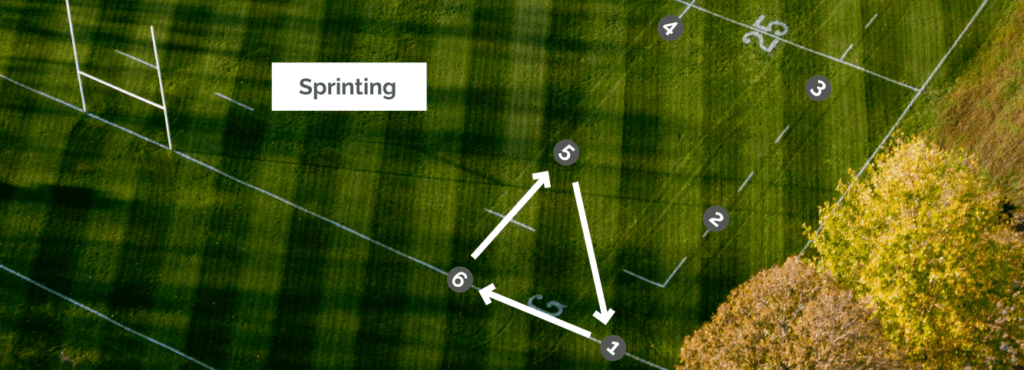The Rectangle – flanker cardio program
- Training Team
- Conditioning, Flankers, Training
Being a flanker in rugby requires a broad mix of skills and abilities. You need to have the speed of a centre, the strength of a hooker and the endurance of… well… a flanker.
If you’re wearing the 6 or 7 jersey, your job is to be seemingly be all over the field. Maintaining an extremely high level of cardiovascular fitness is essential if you’re going to excel in this position.
The flanker cardio program below provides a framework for training to increase your Vo2 max threshold and your ability to replicate bursts of high-intensity all while giving you the functional agility a flanker needs.
SKIP THE BLOG? WATCH THE VIDEO
The Background
How important is endurance for flankers?
Rugby is classified as an anaerobic sport. That is, it requires many bouts of high-intensity work in succession. A lot of research has been done during the 2000s on the relative effort levels of rugby players during a game. In the study linked to above, the researchers found that during their tested game, the average player covered 6,953 m during play (83 minutes). Of this distance, 37% (2,800 m) was spent standing and walking, 27% (1,900 m) jogging, 10% (700 m) cruising, 14% (990 m) striding, 5% (320 m) high-intensity running, and 6% (420 m) sprinting. To summarize, rugby requires athletes to replicate medium to high intensity efforts for the duration of an 80 minute game. Between these efforts, the athletes are usually standing or walking.
This repetition of high-intensity activity makes rugby different to endurance sports in which competitors will perform one extended period of work at moderate intensity with slight fluctuations depending on race conditions. For more on the energy requirements of a game of rugby, checkout this excellent work by the IRFU. In it, they explain that although rugby players need high levels of aerobic fitness, they shouldn’t train the way endurance athletes do. From that article:
It is often suggested that an enhanced aerobic endurance capacity will enable players to meet the energy demands needed in the later stages of a game. However, few sports go non-stop from beginning to end. Game activity is likely to be disrupted by a ball going out of bounds, by fouls, breaks during play, by injuries to players and the interval break. It is not a question of whether the player can last the game rather it is a question of how well the player can reproduce over the 80 minutes the high-intensity bouts of activity that are required of him during play.
So what does this all mean for a Flanker? Do you need aerobic fitness or don’t you? Without much doubt, the higher your level of aerobic fitness, the better your body is going to be able to cope with anaerobic stress. The guys at BokSmart in their definitive work, Periodization in Rugby, cover this topic extensively:
… rugby players need a high capacity of maximum oxygen absorption to minimize oxygen debt resulting in the multiple anaerobic bouts occurring during the game. The more oxygen that can be transported to the muscles during recovery times, the quicker the excess lactic acid can be metabolized to reproduce ATP necessary for muscles contraction. Therefore, the highest VO2max rugby players can develop the better. The aerobic capacity of a rugby player is like the foundation of a house, the stronger the foundation the more solid the house is above. In rugby, as in many other team sports, nothing significant will be achieved without a strong aerobic base.
Aerobic fitness, anaerobic training and Vo2 Max
While its clearly important for flankers to have a high level of aerobic fitness, if you’re looking to make gains in this area, doing long runs is probably not the best way to train. A better option is to focus on replicating bouts of moderate, high-intensity and sprint intervals, with sufficient rest between efforts. This form of anaerobic training will still provide aerobic gains, while at the same time replicating the conditions within a game of rugby. The flanker cardio program below is designed specifically for running, but if you’re more comfortable on an ergo, you could also work with the rowing for rugby we published earlier last year or incorporate a cardio program before rugby training.
One of the best ways to track how your anaerobic training is effecting you aerobic fitness is with a Vo2 Max test. These tests come in a variety of forms, the most common of which is the classic ‘beep test’. Others include the ‘Cooper Test‘, developed during the Vietnam War by the US military in which athletes are asked to run as far as they can in 12 minutes. As therugbyblog.com explains, “…the fastest way to reach your cardiovascular potential is to run intervals at a speed that elicits your VO2 max… this pace is equivalent to 3,000-meter pace or the fastest effort you can maintain for about 8 minutes.”
If you intend to use the flanker cardio program outlined below, we highly highly recommend taking several measurements of your Vo2 Max before you begin and then again after 2, 4, 6 and 8 weeks of using the program. This is the most effective way to determine whether your aerobic fitness is being positively effected by your anaerobic training. Get out there and beep test, guys!
Increase your Vo2 Max with your diet
Last week, we talked about the All Blacks diet during last year’s rugby world cup. In it, we explained that the ABs have modified many of the nutritional principles used by endurance athletes including the use of a LCHF (low carb healthy fat) diet on days when they’re not playing. Besides the ability to kick your metabolism into a ketogenic state, it seems that there could also be aerobic benefits to using a LCHF diet. Again, from therugbyblog.com :
“Research conducted at the University of Maryland Medical Centre shows that you can increase your V02 Max from the comfort of your kitchen. Studies found that consuming a lot of fish such as salmon, herring, rainbow trout and tuna can improve lung capacity since they’re high in omega-3 fatty acids which have been shown to reduce inflammation in the lungs.”
If you’re looking for dietary supplements that have the potential to increase your muscular endurance, checkout either our post-rugby or an No2 booster. Depending on your metabolism, either of these compounds might provide you with endurance benefits.
What does a true Vo2 Max test look like?
Beep tests are pretty evil things. And Cooper tests take a huge amount of mental strength. So if you’re not interested in doing either of those, there’s always the option of performing a true Vo2 Max test on a treadmill and all hooked up to a bunch of wires. To see what this is like, we turn to the Northeastern University Men’s Rugby Team, who together with their school’s Human Performance and Exercise Science Lab can complete a Vo2 Max test in < 2mins.
THE PROGRAM
Why do THIS flanker cardio program?
The cardio program below is designed to replicate a 40 min half of rugby. Benefits include increasing your Vo2 Max and giving you functional agility which is crucial for perfecting your flanker running lines during a game situation. There’s also a mental side to it. You’ll be exercising for the same period of time as you would be playing for a single half. There’s a skill to concentration and this program will help you practice focusing on your job for 40mins.Block 1 – 60m intervals 10+ X 60M @ JOGGING SPEED EVERY 30 SECONDS Time: 10 mins – Distance: 600m+

What the intervals look like
Let’s get down to it. This first block of intervals is performed at ~60% of your maximum effort. You’ll be jogging around a complete rectangle in a clockwise direction for interval #1 and then a counter-clockwise direction for interval #2. You absolutely MUST start a new interval every 30 seconds in order to keep your timing. During your first time through the program, aim to get up to 10 intervals.
That’s exactly 5 mins of work which will leave you 5 mins of rest before starting your next block of intervals. By the time you get to 10, you should be pushing your Vo2 Max. You shouldn’t feel exhausted, but you should be breathing pretty heavily. You’ve just completed a solid 600m of effort in 5 mins. That’s a good starting point. But to really progress with the program, you’ll want to step up to doing 12 intervals next time and so on.
Note: don’t go beyond about 16 intervals. Yes, you might be able to knock these out, but you won’t be getting adequate rest between blocks.
The rest period
Once you’ve completed your 10 30-second intervals it’s time to rest. Remember from our intro that flankers will spend anywhere from 30% – 40% of a rugby game either walking or standing still. Between blocks, complete an active rest period. Walk around, get a drink, do a bit of stretching etc. This period is critical training for your aerobic system which is actively trying to reduce your heart rate and help you recover.
Block 2 – 50m intervals
10+ X 50M @ CRUISING SPEED EVERY 30 SECONDS
Time: 10 mins – Distance: 600m+

Don’t swerve, ‘Chop’ your feet
Block 2 is significantly different to block 1. We’re still technically covering the same distance, but we’ve increased the speed up to ~70% of your max effort and added a walk. This block also involves many more changes in direction than the 60m intervals we started with. You’ll be making five 90° turns and one 180° turn to finish. The trick with these is not to swerve and cut corners using a constant stride length.
Instead, we want to accelerate out of each turn and ‘chop’ our feet as we approach the next turn. This is the functional agility we discussed in the intro. Flankers must be able to not only change direction, but accelerate as they do. This portion of the flanker cardio program is the hardest. If you get through this, you should make it home free.
Block 3 – 40m intervals
10+ X 40M @ HIGH-INTENSITY EVERY 30 SECONDS
Time: 10 mins – Distance: 400m+

Around in squares
By the time we get to block 3, you should be starting to feel it. The first two blocks are the toughest on the aerobic system. Now that we’re using shorter and more intense intervals, you’ll be getting more rest between efforts, not just between blocks. In block 3, we’re working at ~85% of our maximum. Flankers will stay in this effort zone for about 5-7% of a game covering over 350m. If you knock out 10 intervals in this block, you’ll have completed 400m at high-intensity.
Breathe deeply between your intervals to get oxygen out to your muscles as fast as possible. This block gives you more rest, but you’re still coving a significant distance so practice your recovery. As in block 2, accelerate out of each turn and chop your feet before the next turn. Don’t just run a big circle staying outside the markers. Ensure that you’re cutting hard corners as you would be during a game.
Block 4 – 34m Intervals
10+ X 34M SPRINTS EVERY 30 SECONDS
Time: 10 mins – Distance: 340m+

Learn to turn (and chase)
Last block! You’re almost done. In block 4, we’ll be increasing the speed again all the way up to 90+% of maximum. This is the sprint portion of the flanker workout program. It’s also the block with the tightest turn. The block calls for intervals of 34m which is run in a triangle. For the 90° turn, do pretty much exactly what you’ve been doing up to now – but at maximum velocity. For the 135° turn though, you’ll almost be pivoting on the spot and then accelerating back to your starting marker.
This block replicates the ‘turn and chase’ process in a rugby game. Imagine you’re defending and there’s a line break in center-field that you need to cover up for – that’s what you’re practicing for here. Block 4 gives you the most rest between intervals and the shortest distance for intervals. You’re getting it easy now so don’t relax! Now’s the time to really push yourself and maintain a sprint right back to the starting marker. Breathe deeply between intervals getting as much oxygen into the lungs as possible.
REFERENCES
- An evaluation of the physiological demands of elite rugby union using Global Positioning System tracking software
- All photos courtesy of Jay Grabiec/Eastern Illinois University
- Whey Protein can be an effective rugby recovery tool as well


